Indian Apparel Market Analysis
In detail analysis on apparel market in India. Understanding the market size, Revenue generation & profitability opportunities based on demography & psychography of Indian consumer.
APP MARKETINGMARKET CATEGORY RESEARCHDIGITAL MARKETING


India's apparel market is a dynamic and rapidly growing sector, driven by a combination of factors. The country's large population, rising disposable incomes, and growing urbanization have fueled a surge in demand for clothing and accessories. India's rich textile heritage, skilled workforce, and competitive pricing have also made it a global hub for apparel manufacturing and exports. From traditional handloom fabrics to modern fashion trends, the Indian apparel market offers a diverse range of products to cater to various tastes and preferences. The market size of India is approximately 105.50 billion USD and It is anticipated to grow annually by 3.81% (CAGR 2024-2028).
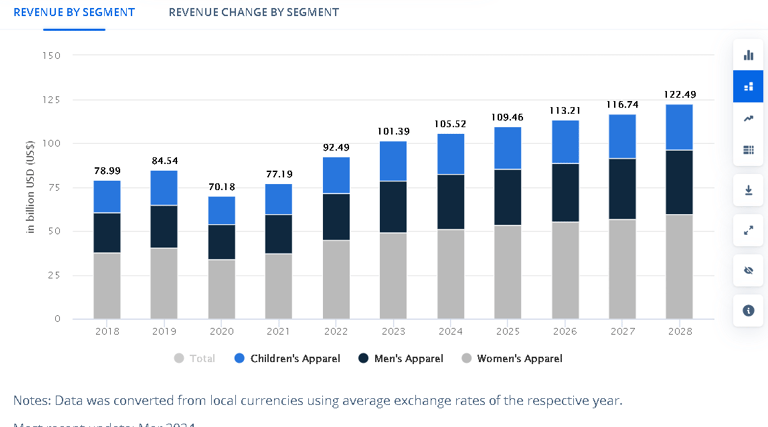

Here is what revenue by segment looks:
The data indicates that out of the $105.5 billion Indian apparel market, women account for 51 billion USD, men for 31 billion USD, and children for 23 billion USD, offers valuable insights into consumer preferences and spending habits.
Women consistently drive the apparel market, accounting for over half of all spending. This suggests that brands catering to women's fashion have a significant advantage. While men make up a slightly smaller portion of the market compared to women, their spending is still substantial. Brands focusing on men's apparel can find a lucrative niche. The children's apparel market is experiencing steady growth, reflecting increasing disposable incomes and a growing emphasis on children's fashion. Brands targeting this demographic can benefit from significant market potential. Its expected by 2028 Apparel market to be 122.5 billion dollar market & segment share women would account for 60 billion USD, men for 36 billion USD, and children for 26.5 billion USD
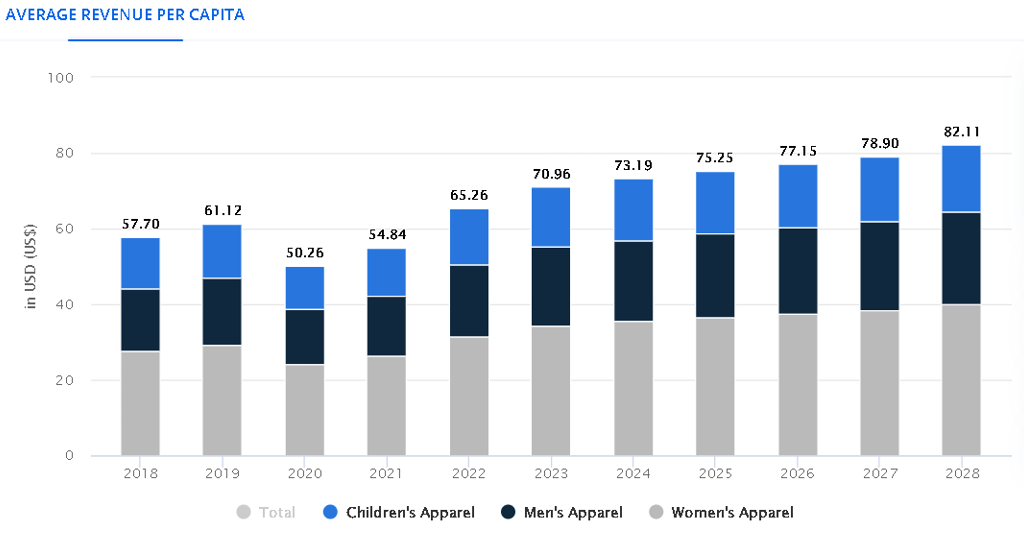

Average Revenue Per Capita:
The data provided above indicates that the average spending on apparel per person in India for 2024 is: Women: $35, Men: $21 & Children: $16.
The average spending per capita on apparel is projected to increase for all demographics between 2024 and 2028. This indicates a growing market and a rising disposable income among Indian consumers. Women consistently outspend men on apparel, both in 2024 and projected for 2028. This suggests a continued trend of women driving the apparel market in India. The growing wealth gap in India could impact spending patterns, with higher-income consumers driving the market.
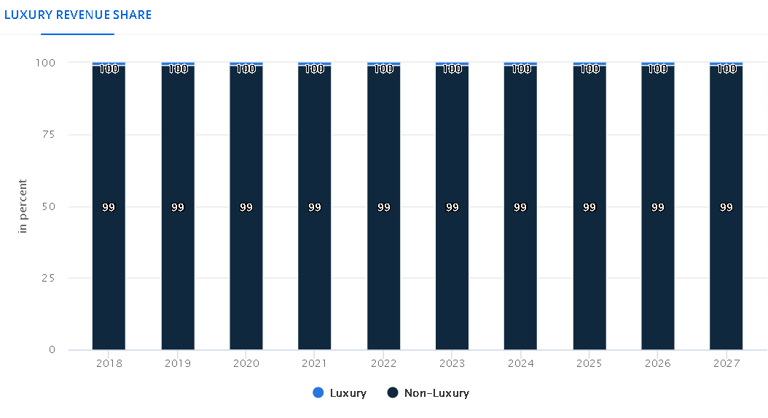

Luxury Revenue Share
Luxury Revenue Share For 2024 Indian Apparel market : Luxury - 1%, Non-Luxury - 99%. The non-luxury segment accounts for a significant 99% of the Indian apparel market in 2024. This indicates a strong preference for affordable and accessible clothing options among the majority of Indian consumers. The luxury segment constitutes only 1% of the market, suggesting that luxury brands have a limited presence or appeal in India compared to other segments.
Luxury brands may need to adapt their marketing and product offerings to cater to the specific preferences and cultural nuances of the Indian market. Incorporating Indian elements or collaborating with local designers can enhance the appeal of luxury brands to Indian consumers. Luxury brands can focus on high-income segments, such as urban professionals and affluent consumers, to increase their market share.
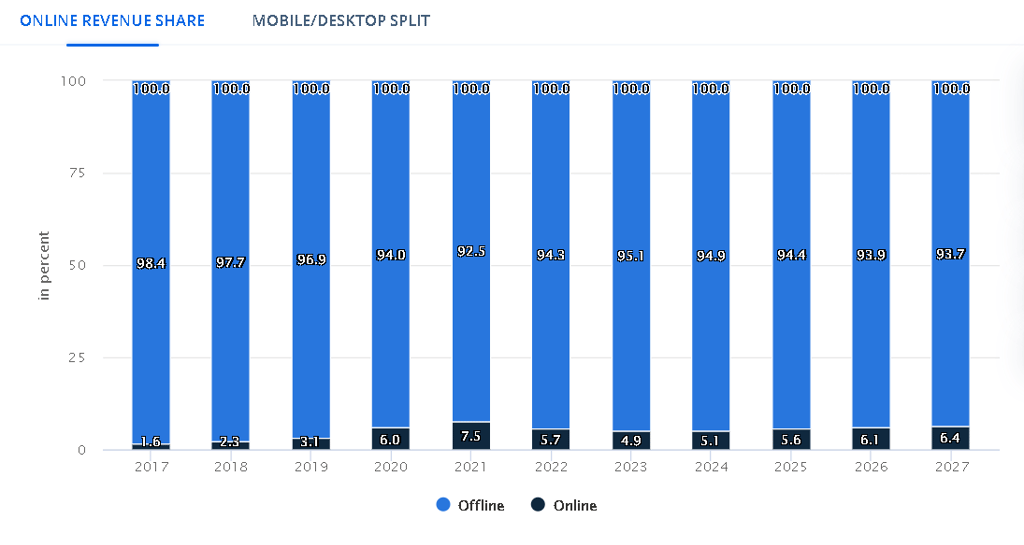

Online Vs Offline Revenue Share
The offline segment continues to hold a significant 94.9% share of the Indian apparel market in 2024. This indicates a strong preference for traditional brick-and-mortar stores among Indian consumers. The online segment, while still relatively small at 5.1%, is expected to grow to 6.4% by 2028. This suggests a gradual shift towards online shopping for apparel.
Retailers need to adopt an omnichannel approach, integrating online and offline channels to provide a seamless customer experience. Providing excellent customer service, including easy returns and hassle-free shopping experiences, is essential to build trust and loyalty.
While the offline segment remains dominant in India's apparel market, the online segment is gradually gaining traction. Retailers that can effectively leverage both channels, offering a seamless customer experience and addressing the challenges associated with online shopping, are likely to succeed in the competitive Indian market.
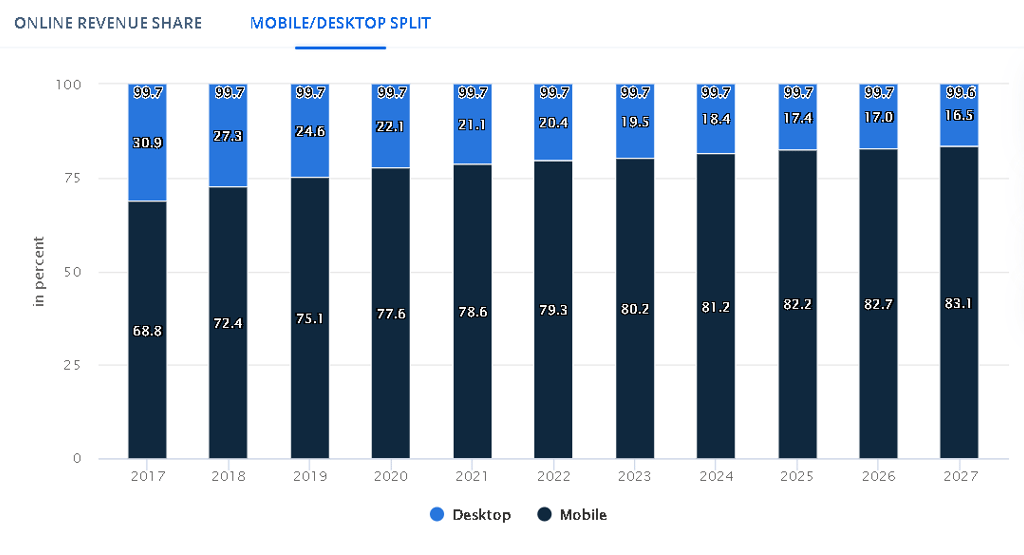

Desktop Vs Mobile Share On Online Apparel Market:
Apparel market share Indian online store 2024: Desktop - 19% Mobile - 81%. Mobile devices account for a significant 81% of the Indian online apparel market in 2024, highlighting the growing popularity of mobile shopping. The mobile share is projected to increase further to 83.5% by 2028, indicating a continued trend towards mobile-first shopping. Retailers are increasingly optimizing their websites and developing mobile apps to provide a seamless shopping experience on smaller screens.
Many online retailers integrate social media platforms into their mobile apps, enabling easy product discovery and sharing. Retailers must prioritize mobile optimization in their website design and app development to cater to the preferences of Indian consumers.
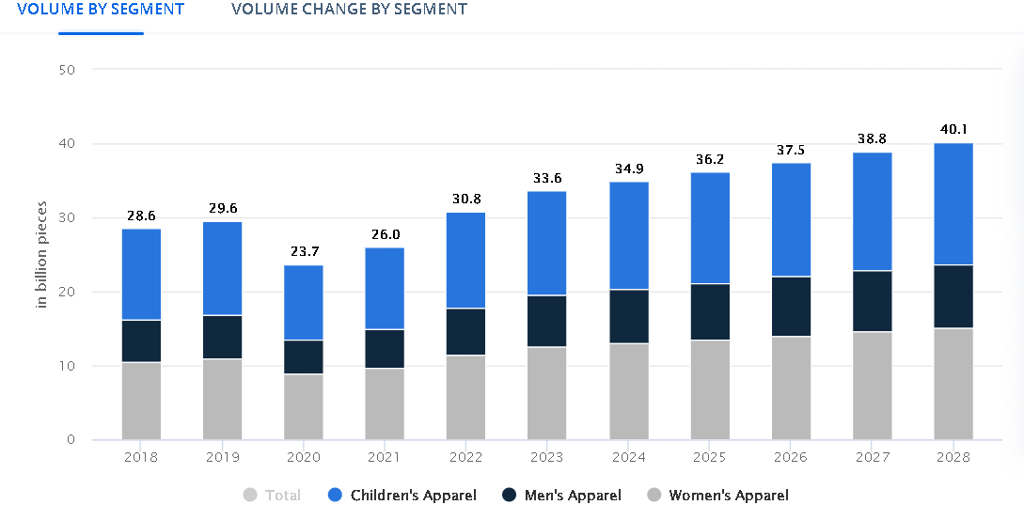

Volume By Segment
For 2024 Apparel Indian (In billions pieces) : Men - 7.3, Women - 13 & Children - 14.6. The children's apparel segment consistently leads in terms of purchase volume, both in 2024 and projected for 2028. This indicates a strong demand for children's clothing and accessories.
All segments are expected to experience growth in purchase volume between 2024 and 2028, suggesting a thriving apparel market in India. Women's apparel remains a significant segment, with a steady increase in purchase volume projected.
Brands can capitalize on the growing children's apparel market by offering a wide range of products and focusing on quality and comfort. Offering a diverse range of apparel options, including sustainable and ethical products, can attract a wider customer base.
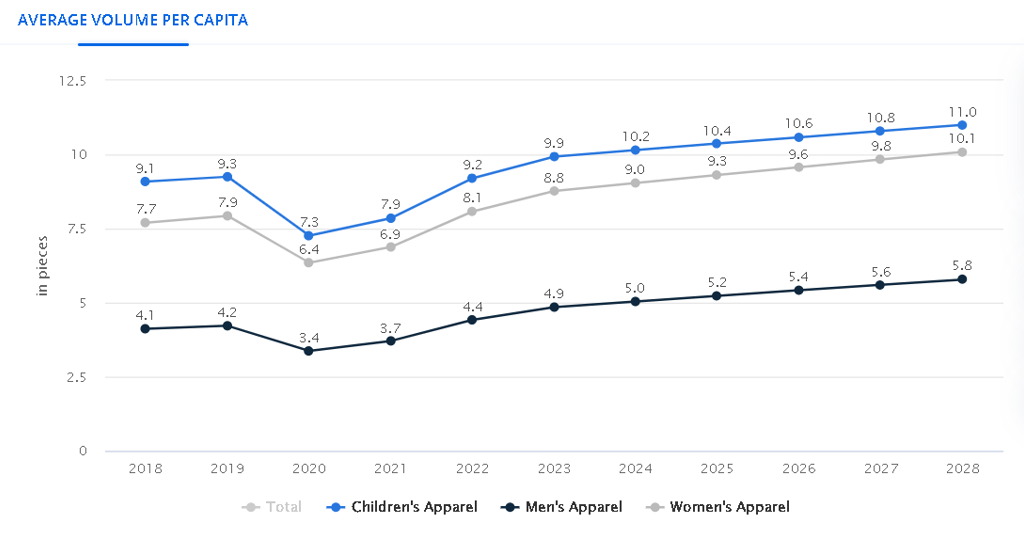

Average Volume Per Capita
Average Volume Per Capita For 2024 (In pieces) : Men - 5, Women - 9 & Children - 10. Women and children consistently have higher average purchase volumes per capita compared to men, indicating a stronger demand for apparel in these segments. All demographics are expected to experience a slight increase in average purchase volume between 2024 and 2028, suggesting a growing market.
Brands can tailor their marketing strategies to specific demographics, especially women and children, to maximize their reach. Building strong customer relationships through excellent service and personalized experiences can drive repeat purchases.
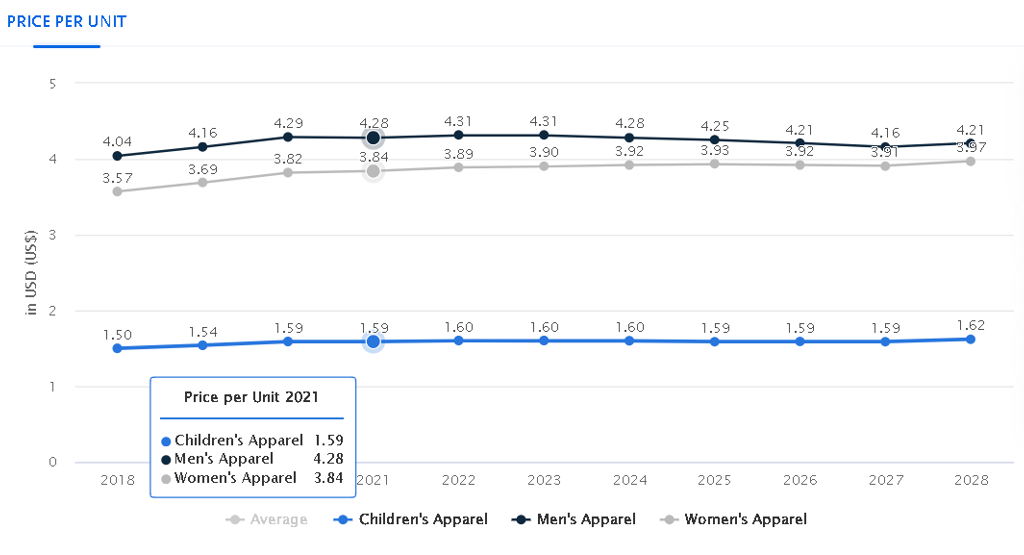

Price Per Unit
Price Per Unit For 2024 (Price per unit in $) : Men - $4.28, Women - $3.92 & Children - $1.6. Men's apparel has a slightly higher average price per unit compared to women's and children's apparel, both in 2024 and projected for 2028. This could be attributed to factors such as the use of higher-quality materials or more complex designs in men's clothing.
The projected prices for all segments show minimal changes between 2024 and 2028, suggesting a relatively stable pricing environment in the Indian apparel market. Brands need to focus on efficient manufacturing processes and cost management to maintain competitive pricing. Offering value for money by providing quality products at reasonable prices is essential to attract and retain customers.
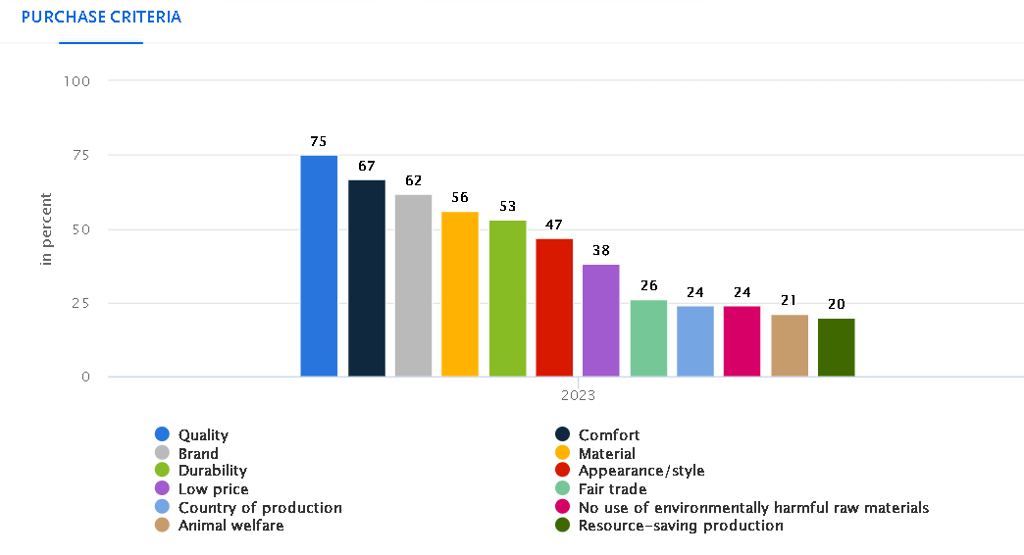

Purchase Criteria
Quality and Brand Dominate: Quality and brand are the most important factors for consumers when purchasing apparel, both scoring 75% and 67% respectively. This suggests that consumers prioritize well-made and reputable brands.
Comfort and Durability: Comfort and durability are also significant factors, scoring 62% and 56% respectively. This indicates that consumers value products that are comfortable to wear and long-lasting.
Price Sensitivity: Low price is a factor for 53% of consumers, indicating that price remains a consideration for many shoppers.
Sustainability and Ethics: Factors related to sustainability and ethics, such as fair trade, animal welfare, and resource-saving production, are less important to consumers, scoring below 30%. While these factors are gaining attention, they still have a lower priority compared to quality, brand, comfort, and durability.
Implications for Apparel Retailers:
Focus on Quality and Brand: Retailers should prioritize offering high-quality products from reputable brands to meet consumer expectations.
Prioritize Comfort and Durability: Ensuring that products are comfortable and durable can enhance customer satisfaction and loyalty.
Balance Price and Value: While price is a factor, retailers should focus on offering value for money by providing quality products at competitive prices.
Address Sustainability Concerns: While sustainability factors may not be the top priority for all consumers, retailers can differentiate themselves by incorporating sustainable practices and communicating their efforts to environmentally conscious shoppers.
